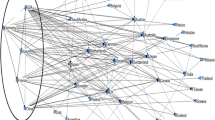Abstract
This paper aims at analyzing and extracting the research groups from the co-authorship network of oncology in China. By use of centrality, component analysis, K-Core, M-Slice, Hierarchical Clustering analysis, and Multidimensional Scaling analysis, we studied the data from 10 Core Chinese Oncology journals between 2000 and 2009, analyzed the structure character of the Chinese Oncology research institutes. This study advances the methods for selecting the most prolific research groups and individuals in Chinese Oncology research community, and provides basis for more productive cooperation in the future. This study also provides scientific evidences and suggestions for policymakers to establish a more efficient system for managing and financing Chinese Oncology research in the future.





Similar content being viewed by others
Explore related subjects
Discover the latest articles and news from researchers in related subjects, suggested using machine learning.Notes
China has 34 “Administrative Divisions”, including 23 provinces, 5 autonomous regions, 4 municipalities directly under the Central Government and 2 special administrative regions.
References
Beaver, D., & Rosen, R. (1978). Studies in scientific collaboration. Part I. The professional origins of scientific co-authorship. Scientometrics, 1, 65–84.
Bordons, M., & Gómez, I. (2000). Collaboration networks in science. In B. Cronin & H. B. Atkins (Eds.), The web of knowledge: a festschrift in honor of Eugene Garfield (pp. 197–213)., ASIS Monograph Series Medford, NJ: Information Today Inc.
Calero, C., Buter, R., Cecilia Cabello Valdés, C. C., & Noyons, E. (2006). How to identify research groups using publication analysis: an example in the field of nanotechnology. Scientometrics, 66(2), 365–376.
Castro, R. D., & Grossman, J. (1999). Famous trails to Paul Erdös. MATHINT: The mathematical intelligencer, 21, 51–63.
Chen, C., & Carr, L. (1999). Trailblazing the literature of hypertext: Author co-citation analysis (1989–1998). In Proceedings of the tenth ACM conference on hypertext and hypermedia: returning to our diverse roots (pp. 51–60). New York: ACM Press.
Cohen, J. E. (1991). Size, age and productivity of scientific and technical research groups. Scientometrics, 20(3), 395–416.
Cronin, B., & Shaw, D. (2007). Peers and spheres of influence: Situating Rob Kling. Information Society, 23(4), 221–233.
González-Alcaide, G., Aleixandre-Benaven, R., & Granda-Orive, J. I. D. (2010). A study of the bibliometry and areas of the research groups of Archivos de Bronconeumología (2003–2007). Archivos de Bronconeumologia, 46(2), 78–84.
Hou, H., Kretschmer, H., & Liu, Z. (2008). The structure of scientific collaboration networks in Scientometrics. Scientometrics, 75(2), 189–202.
Katz, J. S., & Martin, B. R. (1997). What is research collaboration? Research Policy, 26, 1–18.
Liu, X., Bollen, J., Nelson, M. L., & Van de Sompel, H. (2005). Co-authorship networks in the digital library research community. Information Processing and Management, 41, 1462–1480.
Melin, G., & Persson, O. (1996). Studying research collaboration using co-authorships. Scientometrics, 36(3), 363–377.
Nascimento, M. A., Sander, J., & Pound, J. (2003). Analysis of SIGMOD_s co-authorship graph. SIGMOD Record, 32(3), 8–10.
Newman, M. E. J. (2001a). Scientific collaboration networks: I. Network construction and fundamental results. Physical Review E, 64, 016131.
Newman, M. E. J. (2001b). Scientific collaboration networks: II. Shortest paths, weighted networks, and centrality. Physical Review E, 64, 016132.
Perianes-Rodríguez, A., Olmeda-Gómez, C., & Moya-Anegón, F. (2010). Detecting, identifying and visualizing research groups in co-authorship networks. Scientometrics, 82(2), 307–319.
Scott, J. (1991). Social network analysis: A handbook. London: Sage.
Smeaton, A. F., Keogh, G., Gurrin, C., McDonald, K., & Sodring, T. (2003). Analysis of papers from twenty-five years of SIGIR conferences: What have we been doing for the last quarter of a century. ACM SIGIR Forum, 37(1), 49–53.
Subramanyam, K. (1983). Bibliometric studies of research collaboration. Journal of Information Science, 6, 33–38.
Van Raan, A. F. J. (2008). Scaling Rules in the science system: Influence of field-specific citation characteristics on the impact of research groups. Journal of the American Society for Information Science and Technology, 59(4), 565–576.
Vuckovic-Dekic, L. (2003). Authoship-co-authorship. Archive of Oncology, 11(3), 211–212.
Wagner, C.S., & Leydesdorff, L. (2003). Mapping global science using international co-authorships: A comparison of 1990 and 2000. In: Guohua, J. et al. (Eds.), In Proceedings of ninth international conference on scientometrics and informetrics (pp. 330–340). Dalian: Dalian University of Technology Press.
Wasserman, S., & Faust, K. (1994). Social network analysis: Methods and applications. London: Cambridge University Press.
Yan, E. J., Ding, Y., & Zhu, Q. H. (2010). Mapping library and information science in China: A co-authorship network analysis. Scientometrics, 83, 115–131.
Yin, L., Kretschmer, H., Hanneman, R. A., & Liu, Z. (2006). Connection and stratification in research collaboration: An analysis of the COLLNET network. Information Processing and Management, 42, 1599–1613.
Zulueta, M. A., & Bordons, M. (1999). A global approach to the study of teams in multidisciplinary research areas through bibliometric indicators. Research Evaluation, 8(2), 111–118.
Acknowledgments
The research reported in this paper is done as part of the ‘Management Research of University Fundamental Research Innovation System on First-class Young Scientists—with Biomedicine for Example’ (No. 70773072), which is supported by National Natural Science Foundation of China. And it is also supported by Program for New Century Excellent Talents in University (NCET-08-0887).
Author information
Authors and Affiliations
Corresponding author
Rights and permissions
About this article
Cite this article
Yu, Q., Shao, H. & Duan, Z. Research groups of oncology co-authorship network in China. Scientometrics 89, 553–567 (2011). https://doi.org/10.1007/s11192-011-0465-z
Received:
Published:
Issue Date:
DOI: https://doi.org/10.1007/s11192-011-0465-z




